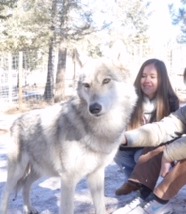Wolves in Colorado once roamed freely and were an important part of the Colorado ecosystem. However, due to government-funded programs, Colorado wolves were targeted. Extermination programs that served to trap and kill wolves were successful in the eradication of the Gray Wolf. Wolves therefore have been nonexistent in Colorado since the 1940s. However, that could all be changing.

In the past several years there have been several unconfirmed wolf sightings within Colorado borders. Some environmentalists believe that their return could be inevitable due to increased reported sightings and higher wolf populations in border states. Yet, others believe that without intentional reintroduction, the possibility of wolves establishing significant populations and packs in Colorado is unlikely. This has sparked a very controversial debate regarding whether or not to reintroduce wolves into the Colorado wilderness.
Those against the reintroduction argue that reestablishing wolf populations in Colorado can harm people and farmers. They fear that wolves will pray on livestock and negatively impact farmer incomes. Yet, in other states where wolves are present, including Minnesota and Wisconsin, there have been negligible occurrences of wolf

attacks on livestock. A possible countermeasure is to instill a program where farmers are compensated for killed livestock in the rare case this does occur. Similar programs have been successful in other areas, but rarely needed. There also is not a strong case against wolves harming humans. As stated in a report by The Sierra Club, "There are virtually no records of wolves harming millions of campers visiting U.S. and Canadian parks yearly."
So, where do we stand!? We had the amazing opportunity to go visit the Colorado Wolf and Wildlife Center in Colorado Springs a few weeks back. We were able to take a tour of the facility where we meet some of the facilities' wonderful wolves. We learned even more about the incredibly important impact wolves have on Colorado's environment.

Counter to popular belief, wolves do not hurt elk and deer populations, but rather, strengthen them. By targeting the sick and weak, they keep populations in top shape and in turn, elk and deer breeding turn out healthier and stronger animals. They help balance the increasingly unstable ecosystem and are integral to a healthy and stable Colorado environment.
After the tour we got up close and personal with two of the center's wolves, Keyni and Makuee. We got to enter their enclosure and quickly learned they love chest and arm pit scratches. We also were exposed to some wolf breath as they like to lick faces and teeth (yes teeth) in order to get to know you better. Playful Keyni and Makuee are featured below.
Prior to our experience at this center, we did not have strong knowledge about the subject of wolf reintroduction into Colorado. However, this business is making great strides in educating us, and the Colorado population, about the importance of wolf reintroduction. We encourage everyone to get informed on this subject. Visit their website to learn more about this important project. Or, go pay them a visit and book an in-person tour!






Comments